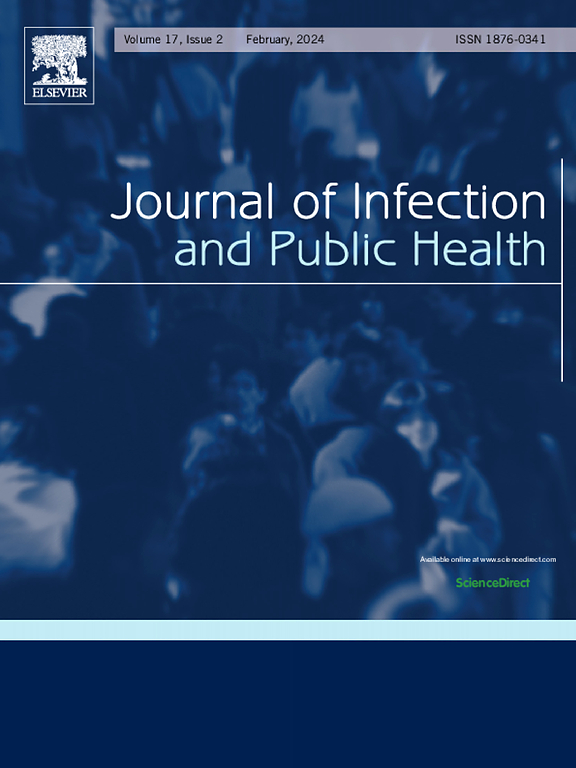Evaluating antibiotic susceptibility trends in S. pneumoniae and H. influenzae isolates during the COVID-19 pandemic: An interrupted time series analysis of a nationwide antimicrobial resistance database
IF 4.7
3区 医学
Q1 INFECTIOUS DISEASES
引用次数: 0
Abstract
Background
The heightened infection prevention measures implemented during the COVID-19 pandemic reduced the incidence of certain other infections; however, the impact of this decrease on antimicrobial susceptibility remains undetermined. Herein, we analyzed data from a large, multicenter, Japanese infectious disease database to evaluate the antibiotic susceptibility trends among bacterial species whose incidence reduced during the COVID-19 pandemic.
Methods
Using a nationwide Japanese AMR database covering hundreds of hospitals, this study applied interrupted time-series analysis to examine level and trend changes in monthly susceptibility rates between the pre-pandemic (January 2018–December 2019) and pandemic (January 2020–March 2023) periods among bacteria whose incidence rates continuously decreased during the COVID-19 pandemic.
Results
Among 2,686,932 isolates of 15 species included during the study period, decreased incidence rates were observed only for H. influenzae (n = 83.376) and S. pneumoniae (n = 72,574). Among H. influenzae and S. pneumoniae, the trend of susceptibility rates for most antibiotics, including penicillins, cephalosporins, carbapenems, fluoroquinolones, and macrolides, did not change during the COVID-19 pandemic. Only the susceptibility of sulbactam/ampicillin for H. influenzae showed an increasing trend of 0.19 % per month (95 % confidence interval [CI]: 0.001, 0.39).
Conclusions
The results of this study were based on data from a large, multicenter database and focused on droplet-transmitted bacteria. We found no susceptibility trend changes during the COVID-19 pandemic. However, the reduced infections observed in the 3-year study period may not be solely responsible for the unchanged susceptibility rates for AMR control. Future studies should explore combined strategies involving reduced infection rates and antimicrobial use to assess bacterial antibiotic susceptibility rates.
评估COVID-19大流行期间肺炎链球菌和流感嗜血杆菌分离株的抗生素敏感性趋势:对全国抗菌素耐药性数据库的中断时间序列分析
在2019冠状病毒病大流行期间实施的强化感染预防措施降低了某些其他感染的发生率;然而,这种减少对抗菌药物敏感性的影响仍未确定。在此,我们分析了来自一个大型、多中心的日本传染病数据库的数据,以评估在COVID-19大流行期间发病率下降的细菌物种的抗生素敏感性趋势。方法利用覆盖日本全国数百家医院的AMR数据库,采用中断时间序列分析方法,研究在2019冠状病毒病大流行期间发病率持续下降的细菌在大流行前(2018年1月- 2019年12月)和大流行期间(2020年1月- 2023年3月)的月易感性水平和趋势变化。结果在研究期间纳入的15种26686932株分离株中,只有流感嗜血杆菌( = 83.376)和肺炎链球菌( = 72,574)的发病率有所下降。在流感嗜血杆菌和肺炎链球菌中,大多数抗生素(包括青霉素类、头孢菌素类、碳青霉烯类、氟喹诺酮类和大环内酯类)的敏感性趋势在COVID-19大流行期间没有变化。只有舒巴坦/氨苄西林对流感嗜血杆菌的敏感性呈每月0.19 %的增加趋势(95 %可信区间[CI]: 0.001, 0.39)。结论本研究基于大型、多中心的数据库数据,重点研究了飞沫传播细菌。在COVID-19大流行期间,我们没有发现易感趋势变化。然而,在3年的研究期间观察到的感染减少可能不是AMR控制易感性不变的唯一原因。未来的研究应探索包括降低感染率和抗菌素使用的联合策略,以评估细菌的抗生素敏感性。
本文章由计算机程序翻译,如有差异,请以英文原文为准。
求助全文
约1分钟内获得全文
求助全文
来源期刊

Journal of Infection and Public Health
PUBLIC, ENVIRONMENTAL & OCCUPATIONAL HEALTH -INFECTIOUS DISEASES
CiteScore
13.10
自引率
1.50%
发文量
203
审稿时长
96 days
期刊介绍:
The Journal of Infection and Public Health, first official journal of the Saudi Arabian Ministry of National Guard Health Affairs, King Saud Bin Abdulaziz University for Health Sciences and the Saudi Association for Public Health, aims to be the foremost scientific, peer-reviewed journal encompassing infection prevention and control, microbiology, infectious diseases, public health and the application of healthcare epidemiology to the evaluation of health outcomes. The point of view of the journal is that infection and public health are closely intertwined and that advances in one area will have positive consequences on the other.
The journal will be useful to all health professionals who are partners in the management of patients with communicable diseases, keeping them up to date. The journal is proud to have an international and diverse editorial board that will assist and facilitate the publication of articles that reflect a global view on infection control and public health, as well as emphasizing our focus on supporting the needs of public health practitioners.
It is our aim to improve healthcare by reducing risk of infection and related adverse outcomes by critical review, selection, and dissemination of new and relevant information in the field of infection control, public health and infectious diseases in all healthcare settings and the community.
 求助内容:
求助内容: 应助结果提醒方式:
应助结果提醒方式:


